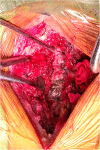The accuracy of a novel pedicle screw insertion technique assisted by a special angular scale in the subaxial cervical spine using lateral mass as a reference marker
- PMID: 33228707
- PMCID: PMC7681976
- DOI: 10.1186/s13018-020-02054-1
The accuracy of a novel pedicle screw insertion technique assisted by a special angular scale in the subaxial cervical spine using lateral mass as a reference marker
Abstract
Background: Posterior cervical pedicle screw (CPS) internal fixation has better biomechanical stability than other posterior cervical fixation methods. However, this technique is limited in clinical practice due to the complex anatomical structure and the adjacent relationship of the cervical pedicle, and the high risk of neurovascular injury. The purpose of this study was to describe a novel subaxial CPS insertion technique assisted by a special angular scale using lateral mass as a reference marker and to evaluate the accuracy of CPS placement and the distribution characteristics of CPS misplacement.
Methods: A total of 36 patients with subaxial cervical spine diseases who underwent posterior CPS fixation were consecutively selected. The optimal entry point on the posterior surface of the lateral mass was identified on the three-dimensional cervical model reconstructed from preoperative computed tomography (CT) images. The pedicle transverse angle (PTA) and pedicle-lateral mass angle (PLMA) were measured on the transverse and sagittal CT images respectively. The pedicle screws were inserted according to the preoperatively planned entry point and angles. We analysed the postoperative CT images for CPS misplacement rates and perforation directions following the Lee classification.
Results: Overall, 177 pedicle screws were inserted, of which 119 (67.2%) were classified as grade 0, 43 (24.3%) as grade 1, 12 (6.8%) as grade 2 and 3 (1.7%) as grade 3 by the postoperative CT images. The accuracy rate of CPS placement was 91.5%. Of the 15 misplaced pedicle screws (grades 2 and 3), 11 were lateral pedicle perforations, 3 were superior perforations and 1 was an inferior perforation. There were no neurovascular injuries related to CPS misplacement.
Conclusions: With our technique, the optimal entry point and two angles (PTA and PLMA) were identified for CPS insertion. The novel CPS insertion technique assisted by a special angular scale provides high accuracy and few complications.
Keywords: CPS; Lateral mass; Optimal entry point; PLMA; PTA; Special angular scale.
Conflict of interest statement
The authors declare that they have no competing interests.
Figures









References
MeSH terms
Grants and funding
LinkOut - more resources
Full Text Sources
Medical

